Published
on 27
Apr 2018
|
All rights reserved.
|
|

|
|
Built
on the success of last gen, the new A-class wants to capitalize on
style and premium feel to capture more sales...
|
|
This is the fourth
generation A-class, or the second since it was reborn as a conventional
hatchback 6 years ago – you should remember the first two generations
were built on the unique sandwich structure. The switch to MFA platform
has been proved correct, as it accommodates a wide range of variants,
i.e. B-class, GLA and CLA, and together they captured 620,000 sales
last year. Now one in three Mercedes are the small cars.
Thanks to its success, the Mk4 model is built on an updated version of
the existing platform, or we can call it MFA2. Its wheelbase has been
stretched by 30mm to 2729mm, while overall length is even longer
(+127mm), ditto the width (+16mm) and height (+7mm). Curiously, the new
car’s body profile is boxier, as its roof gets flatter and the rear
door windows get squarer. These changes intend to improve cabin space
and make entry and exit the rear seat easier. On the flipside, the car
looks a bit less dynamic hence not quite as special as before. Up
front, the new nose design is controversial. While design chief Gorden
Wagener described it as “pure and emotional”, I think otherwise.
Following the recent CLS, it adopts a new front grille and headlamps
that look like upside down. This hurts the sense of sleekness a little,
and it takes some time getting used to. Nevertheless, contrary to
perception, the new car has its aerodynamic drag improved. Not just
improved, but it is easily class-leading at merely 0.25, a figure
unknown to compact hatchbacks. To that end, the car employs active
shutters at both the upper and lower grille. These shutters are
normally closed except in summer or when you drive hard, at least for
the moderate climate in Europe.
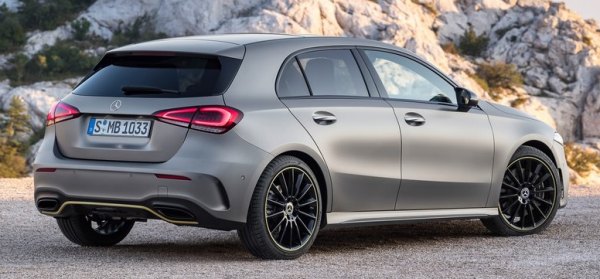
|
|
Learned
from VW Golf, most A-class models has switched to torsion beam rear
axle.
|
|
Predictably, the chassis employs higher percentage of high and
ultra-high strength steel to enhance rigidity, while more attention to
NVH suppression was paid to address the complaints associated with its
predecessor.
One big change is the suspension. To reduce cost, Mercedes learns from
Volkswagen Golf to equip the cooking models (i.e. A180d and A200) with
torsion-beam rear axle, while more powerful models (A250 or above)
employ 4-link suspension mounted on subframe. The wheel carriers and
spring control arms are made of aluminum to cut unsprung weight. Up
front, all models employ MacPherson strut setup, expectedly, but again
weight is saved by using forged aluminum transverse control arms and
cast aluminum steering knuckles. There are 2 options for suspension
tuning: a standard comfort setting or AMG Line setting (stiffer and
15mm lower). In addition, you can opt for adaptive dampers. It has to
be noted that in Europe, the AMG suspension, adaptive dampers and
4matic option mandate the multi-link rear suspension, so you can
actually buy an A180d and A200 with the independent rear axle, although
it won’t be cheap.

|
|
Cx
of 0.25 is easily class-leading, no wonder A200 can top 140 mph.
|
|
In the beginning, the A-class offers only 3 models:
A250: it is powered by the M260 2-liter turbo engine, which is the
transversely mounted version of the M264 we have seen on E350
Coupe/Cabriolet. It produces 224hp, up 13hp from before. New features
include Camtronic 2-stage variable valve lift, friction-reducing
conical shape cast iron cylinder liners, piezo injection, electronic
wastegate and a centrifugal vibration damper to support the
twin-balancer shafts. The A250 is faster than a Golf GTi Performance.
It is good for the voluntary limit of 155mph and 0-60 mph is done under
6 seconds.
A200: it introduces the new M282 1.33-liter turbo motor co-developed
with Renault-Nissan (the latter calls it 1.3 TCe 160, annoucned in last
December). Interestingly, Renault-Nissan describes its plasma-spray
bore coating as taken from GT-R, while Mercedes uses its patented
Nanoslide trademark to call it. The Mercedes unit produces a remarkable
163hp and 184lbft of torque. It features a new, compact delta-shape
cylinder head, 250bar direct injection and electronic wastegate as well
as cylinder deactivation which shuts down the center two cylinders at
partial load to save fuel. Thanks to the car's slippery shape, A200 is
good for 140mph, amazing for a 1.3-liter car! It is also pretty light
on feet, taking only 7.6 seconds to go from 0-60.
A180d: this is the least interesting, not least because small diesel
engines are dying but also because it is an updated version of the
Renault 1.5d engine used previously. Its output is improved slightly to
116hp and 192lbft thanks to some refinement like higher injection
pressure. Emission is taken more seriously by using SCR and particulate
filter. Performance of A180d is, well, not worth mentioning.
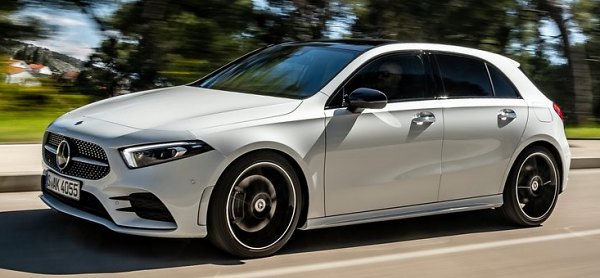 |
|
Don’t
be fooled by its numbers and looks: it is not a hot hatch at all.
|
|
Apart from the standard 6-speed manual, the A-class offers
two different 7-speed twin-clutch gearboxes, one supplied by Getrag for
lower power models (like Renault) and another is built in-house for
A250.
Plenty of new parts, but how is the summation of them perform in the
real world? In terms of powertrain, it is just average. The A180d is
predictably slow, too slow to feel fun, even though the Renault diesel
motor is refined to cruise. The 1.3-liter motor of A200 is much faster,
but it lacks the refinement a premium hatch deserved. It is not as
smooth as its small capacity suggested, and its exhaust sounds coarse
once revving beyond 4000 rpm. It reminds me that Mercedes has always
been failing to build good small engines. The 2.0-liter unit is much
better, but it doesn’t rev as freely as that of Golf GTi, and the A250
doesn’t feel as quick as its numbers suggested. Even though both DCTs
work flawlessly, neither powertrains could put smile on the face of
keen drivers.
The same story can be told to its chassis. The car riding on multi-link
suspension and adaptive dampers is dramatically more refined than the
last generation (which was not a good benchmark in this respect,
admittedly). It tackles all bumps but the largest potholes with ease.
The cabin is also remarkably hushed at high-speed cruising, something
worth the Mercedes badge. Maybe the cheaper models with torsion-beam
axle will suffer from more ride harshness and noise, but still it
should be no worse than the class norm.
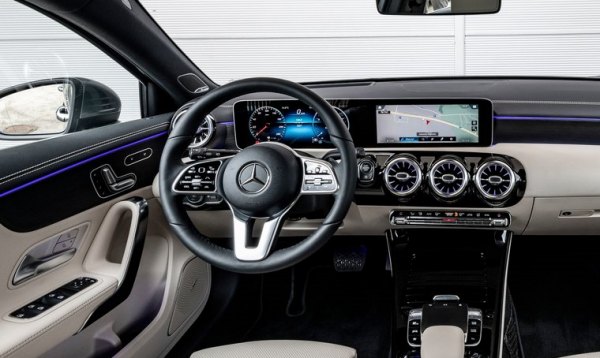
|
|
It
easily trumps Audi A3 and tops the desirability chart in C-segment.
|
|
However, the problems lie on an uninspiring handling. The new A-class
offers plenty of grip and stability in bends, but its steering is very
light and detached, very much like an S-class, while the brake pedal is
over-assisted and has a long long travel. It is not tuned by somebody
love driving! Moreover, the A250 displays more roll and softer response
in corner than a Golf GTi or BMW 1-Series, so don’t be fooled by its
numbers and looks: it is not a hot hatch at all.
So what is it? A luxury hatchback. Open the door and you will see an
environment whose design and build quality not far below the level of
S-class. While I don’t like the loss of shapely instrument pod and
center console, it is undeniable that Mercedes’ use of large upright
TFT screens, chromed jet vents and all the materials and surface
finishing are close to impeccable. It easily trumps Audi A3 and tops
the desirability chart in C-segment. Maybe the cars with base trim and
standard 7-inch screens could be less desirable, but if you buy this
car, I suppose you should sell whatever you have to upgrade to the
twin-10.25-inch screens and all the expensive trims, because the true
Mercedes experience is never cheap. The space offered by this cabin is
not necessarily more than before (maybe a bit more rear head and elbow
room, if not legroom), but it doesn’t matter, as a look and touch of
the sophisticated cabin will put all questions behind and seal the
purchase. I guess many buyers could forgive its uninspiring handling
and engines once they have seen the fabulous interior.
That said, desirability aside, is the new A-class good enough to fight
with the best of the class? I doubt. If you pay more than £30K on
a family hatch, you should expect not only a classy packaging but also
a classy driving dynamics. A Volkswagen Golf GTi is clearly a better
all-rounder yet cheaper to buy. A Golf R costs the same but rests in a
different league. Many others drive better for a fraction of its price.
The baby Mercedes will be a sale success, undoubtedly, but under its
luxurious clothes it lacks a soul to connect to the driver.
|
Verdict:     |
| Published
on 16
Oct
2018 |
All rights reserved.
|
|
A-class Sedan
|
|

|
|
Unexpectedly,
adding a boot to the A-class hatchback does not destroy its shape.
|
|
This
is the first really compact Mercedes sedan since the 190E. It is
created primarily for the consumption of the North America and China
market, no wonder production takes place at Mexico, China and Germany.
Unexpectedly, adding a boot to the A-class hatchback does not destroy
its shape. It still looks handsome, a bit more dynamic and stylish than
its sole direct rival, Audi A3 sedan. The boot adds 130mm to the car's
length and 50 liters to luggage space, boosting the latter to 420
liters. The wheelbase is unchanged at 2729mm, but China gets an extra
60mm from its long-wheelbase version. Thanks to underbody paneling,
active grille shutter and special attention to assembly gap sealing,
the A-class sedan achieves a record-breaking drag coefficient of 0.22,
down from the hatchback’s 0.25 and beats even the teardrop CLA. Maybe
car makers could break the 0.20 barrier in the next decade.
Inside, predictably, the sedan shares the hatchback’s quality dashboard
with twin-flat panel display and 5 jet vents. It feels expensive,
modern and desirable, more so than Audi. The rear seats offer good head
and leg room for 2 adults, but no more than needed for a compact car
sitting under C-class.
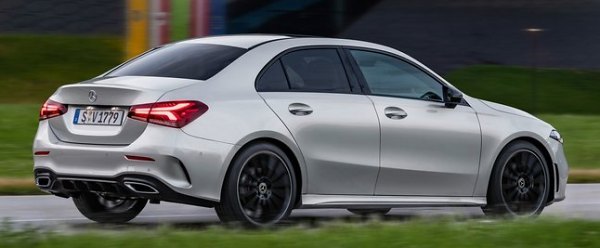
|
|
0.22
Cd breaks world record
|
|
Dynamically
it has no discernible differences from the hatchback, except offering
less performance. While the hatchback is topped by the 224hp A250
before taking AMG into the equation, the sedan makes do with 190hp
A220. Its engine is mostly the same 2-liter turbo, but detuned. 0-60
mph takes just under 7 seconds, or a bit quicker with 4matic system.
Performance is plenty and engine refinement is good. Mercedes’ 7-speed
DCT gearbox works well on highway but a bit clunky at low speed.
Like the hatchback, front-wheel-drive cars ride on cheap torsion-beam
rear axle, while 4matic or adaptive damper option are served with a
multi-link setup. With the more expensive suspension equipped, the
A-class sedan rides well, miles better than the harsh CLA, thanks in
part to its chassis solidity. The steering is a bit more communicative
than that of the hatchback. Body control is good, and the 4matic serves
up good grip. Dynamically, this car is not far off the standard set by
VW Golf, just not quite as light on its feet or as precise in some
controls. Though not tested, torsion-beam suspension might sacrifice
some ride comfort.
Ultimately, the A-class sedan is neither a dynamic leader nor the most
comfortable. It feels a premium product, but you pay extra for that.
This makes a larger Volkswagen Passat a more sensible alternative.
|
Verdict:     |
| Published
on 9
Dec
2018 |
All rights reserved.
|
|
AMG A35
|
|

|
|
The
A35 is the most affordable AMG ever, but it still able to crack 60mph
in 4.5 seconds.
|
|
Like
rivals Audi and BMW, Mercedes is forming a 2-tier strategy for its AMG
models. Sitting below the forthcoming A45 is this A35, which will
target at the same audiences as BMW M140i, Audi S3 and the class
leader, Volkswagen Golf R. Like the last two, the A35 is 4-wheel-drive,
and it is powered by a 2-liter turbo motor with around 300 horsepower.
It tops a regulated 155mph and sprints from rest to 60mph in merely 4.5
seconds, not much behind the A45. Moreover, being sold at
£36,000, it is the most affordable AMG ever. To the fans of AMG,
this must be a dream come true.
Mind you, £36,000 is only the starting price. If you tick the
adaptive dampers, executive package (leather, large touchscreen,
steering wheel switches etc.), styling pack (19-inch wheels, black rear
spoiler, diffuser, front splitter and winglets as shown in these
pictures), AMG bucket seats and a few personalized options, it will be
in the mid-£40K territory. However, so equipped, nothing in this
class can offer such a desirable feeling, especially its stylish and
expensive-looking interior.
The A35’s engine is modified from the M260 unit of A250 rather than the
M133 unit of the old A45. The basics remain, including Camtronic
variable valve lift, but its single-scroll turbo has been replaced with
a larger twin-scroll turbo, and the air-to-air intercooler has been
replaced with a more effective air-to-water unit. Output is boosted to
306hp, while peak torque is 295 lbft. The 7-speed twin-clutch gearbox –
no manual gearbox offered – is modified from the unit of A250 as well,
but it gets specific radios and programming, including the addition of
Race Start mode.

|
|
The
4matic sends up to 50 percent torque to the rear axle, but just when
the front slips...
|
|
The 4matic
system normally drives the front axle. In extreme cases, it may
transfer up to 50 percent torque to the rear, so it is no different to
its counterparts from Volkswagen group. Unlike the old system on A45,
its rear-mounted multi-plate clutch is electromechanical instead of
electrohydraulic, so to quicken response. Moreover, its operation is
predictive, rather than only reactive to front wheel slippage.
To improve steering precision, the A35's front chassis has been
reinforced with 2 diagonal underbody braces, and an aluminum plate is
bolted under its engine. The front suspension gets new aluminum lower
wishbones with rigid ball joints instead of rubber bushings. Other
bushings are stiffened to reduce slack, while the rear subframe is
rigidly mounted to the monocoque. Adaptive dampers are available. The
brakes have been upgraded, using 350mm discs and 4-pot calipers up
front, 330mm discs and single-piston calipers at the rear.
Enough technical details. How does the A35 drive on road?
To be honest, it is not as exciting as its outstanding 0-60mph time
suggested. Take the engine for example, apart from the artificially
induced pops and crackles on overrun, it feels quite normal for a hot
hatch engine. There is no much turbo lag to be detected, but the AMG
motor does not feel especially eager low down. Its peak torque is
produced at a relatively high 3000-4000 rpm (Golf R, Megane RS Trophy
and Civic Type R achieve at 2000, 2400 and 2500 rpm, respectively), so
you need to push harder to get the best of it. You might say this
inspire the driver to work harder thus should be more enjoyable, but it
is not the case, because peak power is reached at a relatively low 5800
rpm, and the twin-clutch gearbox would upshift automatically early.
This means you have a narrower power band to play with. Ferrari
deliberately limits the low-down torque of its turbocharged V8 for a
more naturally-aspirated feel. The AMG A35 plays the same linear chord,
but unfortunately, it doesn’t have a 5-octave vocal range.

|
|
The
AMG A35 plays the same linear chord as Ferrari, but unfortunately, it
doesn’t have a 5-octave vocal range.
|
|
At 1480kg,
the A35 is heavier than its rivals. However, its heavily reworked
chassis and suspension keep the negative effect to the minimum. The
stiff suspension setting might sacrifice some ride comfort, but it
keeps the body control tight. On most roads, its ride is reasonably
comfortable, but on sharp bumps it might run out of suspension travel
and transmit abrupt shocks to your seat of the pants. A Golf R just
won’t do that on the same surfaces.
Thanks to the stiffer front structure, the steering is highly accurate,
and its response is linear. Nevertheless, it lacks feel. You might say
every modern electrically assisted steering rack does the same, but
somehow, the helms of Golf R, Civic Type R or even Megane RS offer a
bit more feel than the AMG. Maybe they have less weight to deal with,
or simply because their manufacturers are more expertized in tuning hot
hatches.
Still, the A35 is a very quick A-to-B car, regardless of weather. Its
4matic offers bags of grip and traction. So much that it won’t break
its rear end lose no matter how hard you try. You want lift-off
oversteer like Type R? or a 4-wheel drift like the old Lancer Evo? Or
crazy drift like the last Focus RS? Sorry, they are no options here.
The A35 just sticks to the line like on rails, with not much understeer
and absolutely no oversteer to speak of. It is therefore very fast
point to point, but in the process it gives you little excitement.
If this car targets at the same crowd of Audi S3, it would be
considered as a huge success, not least because the Mercedes is more
stylish and more upmarket-feeling. If it wants to take the hot hatch
crowns from Civic Type R or Golf R, sorry, its target is widely missed.
Although we know the upcoming A45 will be developed from much the same
chassis, we still hope AMG would rethink its strategy. More power comes
more responsibility. Approach GKN Twinster please.
|
Verdict:     |
Published
on 8
Mar 2020
|
All rights reserved.
|
|
AMG A45
|
|

|
|
New
A45 S is the first hatchback to crack the 4-second barrier of 0-60, but
it is far more than numbers...
|
|
The
original A45 AMG is a milestone in automotive history. Never before had
we seen a hot hatch possessed 360 horsepower, neither a 2.0-liter
four-cylinder engine could muster such a high output. For comparison,
the contemporary Audi 2.5-liter five-cylinder engine managed only
340hp, and most hot hatches ran less than 300. A couple of years down,
AMG improved it further to 381hp. Unfortunately, like many AMG cars in
the past, it was all about engine and straight line performance,
whereas the rest of the car were not quite as remarkable, especially in
terms of driver engagement. As a result, its limelight was taken over
by Renault Megane RS, Volkswagen Golf R and Honda Civic Type R very
soon.
The second generation A45 catches attention again with incredible power
and performance. Now the new bar is 421hp, still coming from the same
2-liter four-cylinder format, so the specific output is an
unprecedented 210 hp per liter. It takes over the lead from the latest
version of Audi 2.5-liter five-cylinder, now good for 400 horsepower
and 160 hp per liter. However, does it have the right chassis and the
right package to match? We shall see…
In terms of design, few could do better than the AMG. The second
generation A-class is already an elegant package, thanks to a longer
nose hence a sleeker shape than most hatchbacks. On the top of this,
AMG added a “Panamericana” grille from the AMG GT R sports car, 19-inch
alloy wheels and red brake calipers to make the car look a lot hotter,
even angrier. Further aggression can be achieved with optional aero
kits, including the black front splitter and rear spoiler as shown in
these pictures. Inside, AMG sports bucket seats and some amazing decors
enhance the A-class’ already stylish, high-quality and advanced
interior further. Yes, at £50,000 the car is very expensive for a
hot hatch, actually more expensive than bespoke sports car like Alpine
A110 and Porsche 718, but considering its build standard and huge
performance, it is by no means overpriced.
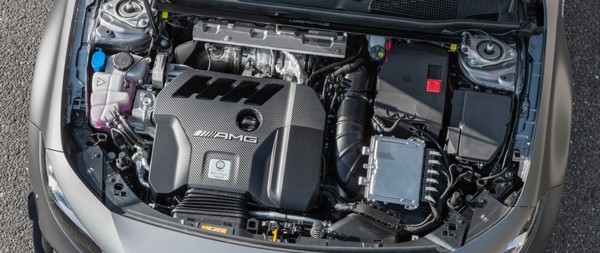 |
|
Extremely
powerful aside, the M139 shall be praised for a linear power delivery,
thanks to Ferrari-style boost control design.
|
|
The highlight of this car remains to be its engine. The M139 unit is
still hand-built by the "one man one engine" policy of AMG at its
Affalterbach factory. It is still a 1991 c.c. four-cylinder, but
everything else is new. A chill-casted aluminum block with closed
deck construction allows it to take unprecedented stress. The
cylinder bores are coated with “Nanoslide”
process to reduce friction, explaining why it can rev to a remarkable
7200 rpm. Fuel injection combines the advantage of spray-guided
direct injection (using piezo injectors instead of solenoids) and
port injection, allowing the engine to switch between
the two
modes depending on load. Similarly, Camtronic
mechanism is used at the exhaust side to provide 2 different valve
opening durations. The M139 does not use dry-sump lubrication,
understandably for a mass production engine, but its sump incorporates
baffle plates to withstand high g-force.
For a more straightforward breathing, the engine is rotated by 180
degrees in the engine bay. This means now the exhaust side accompanied
with turbo is located near the firewall, while the intake side faces
the nose. Predictably, cooling to the turbocharger becomes more
difficult, so AMG has developed a complicated charge cooling system
which involves not one but 3 coolant circuits (air, water and oil). The
intercooler uses a 2-stage water cooling system as before, but the
design is adapted to the engine installation and improved. As the hot
turbo is close to firewall, heat shielding needs to be enhanced, too,
as you can see from the picture. One small change leads to many extra
works. I am impressed that AMG saves nothing in the pursuit of extra
performance.
The large turbo itself remains a twin-scroll
design – don’t understand why motoring journalists spent so many words
to describe the principle and advantage of this, as if it was a new
invention – but now it uses roller bearings to spin faster, and it can
produce a boost pressure of 2.1 bar instead of the previous 1.8, which
explains most of the increased output. A new electronic wastegate is
used so that the ECU can precisely control the boost level. Here, AMG
adopts a new turbocharging strategy not unlike that of Ferrari: it
deliberately limits the boost level at lower rpm, resulting in a linear
delivery closer to a large-capacity naturally aspirated engine. While
the old M133 engine had its peak torque produced from 2250 rpm, the new
motor holds that until 5000-5250 rpm, closer to the horsepower peak of
6750 rpm. This means you will find real benefits and fun to chase rpm.

|
|
The
A45 is not just about power and speed, it is also very versatile.
|
|
The net
result? The A45 S offers 421 horsepower and 369 pound-foot of torque,
good for 0-60 mph in 3.8 seconds and 168 mph top speed, yet the
latter is electronically limited. A cheaper A45 model has these figures
reduced to 387 hp, 354 lbft, 3.9 sec and 155 mph, and it has less
chassis goodies, but let’s keep our focus on the top model.
The transmission system receives no less attention. A new dual-clutch
gearbox is not only beefed up to take on the extra torque, but it has 8
instead of 7 ratios. The 4matic+ all-wheel-drive system is all-new.
While the old one used a Haldex-type multi-plate clutch to engage the
rear axle for part-time function (hence a lot of understeer), the new
one employs a pair of multi-plate clutches at the rear axle, one
responsible for each rear wheel, to implement variable torque split and
torque vectoring. It even includes a Drift mode, although I suspect
that won’t be as effective as the rear-drive-based 4matic+ system on
E63 S etc. Frankly, the mechanical principle of this 4WD system is not
transparent to me, as AMG provides neither detailed descriptions,
technical drawings nor even an exterior photo for our inspection. Its
press release described the hardware as “a rear differential with 2
multi-discs clutches”, but I suspect it doesn’t mean the inclusive of a
real differential. If there was really a rear differential, the 2
clutches would have functioned like an active LSD (i.e. engage the
clutch of one side will direct torque to the other side), and then it
will need a center differential or a center multi-plate coupling to
split torque between front and rear axle. Since AMG did not mention any
center differential or coupling, the best I can imagine is a principle
similar to the GKN Twinster system used on the last Ford Focus RS. In
that case, there is no center or rear differential, just a pair of
multi-plate clutches at the rear. You can read more about Twinster
in AutoZine Technical School. In short, it is able to provide
rear-biased torque split, if not completely rear-drive, and the
rear-axle torque vectoring is found very useful in enhancing driving
fun. Moreover, it doesn’t add too much weight. As the A45 S is only 80
kg heavier than its much less powerful A35 sibling, this assumption
seems reasonable.
The chassis of A45 S is strengthened in various places: an aluminum
stiffening plate is bolted underneath the engine; Tower brace is added
across the front suspensions; A-pillars are strengthened; Diagonal
braces are added to the front and rear underbody. The suspensions sport
revised geometry, wider tracks and many upgraded components, including
new aluminum lower control arms at the front axle. FSD dampers are
standard, but most buyers will opt for adaptive dampers, which has 3
stiffness settings. Larger brakes and 245/35ZR19 Michelin Pilot Sport
4S rubbers complete
the package.
 |
|
No
one else could maintain a neutral handling as good as this car.
|
|
On the Road
The M139 engine is superb. For a such a heavily boosted turbo motor,
its turbo lag is surprisingly subtle. Yes, there is not much shove on
offer at
the bottom end, but it picks up linearly and smoothly from around 2500
rpm,
getting really serious from 4000 rpm upward. The more rev, the stronger
it goes, and the more noise it produces. It is eager to hit the 7200
rpm limiter. The noise is rich and entertaining, as good as you can get
in a four-cylinder car. Depending on rev and drive mode, it growls, it
whooshes, it pops and crackles. When it cruises on highway, it calms
down to a muted thrum. You won’t expect such a versatile manner.
The 8-speed DCT does the job well, too. Although it is not the slickest
of its kind, up and downshifts are done promptly, much better than the
7-speed unit on lesser A-class.
Performance is first rate, of course. It can easily eat any hot hatches
for breakfast, Civic Type R and Megane RS Trophy included. Part of its
outstanding real-world performance come from the 4WD system. Like Audi
RS3, it offers bags of traction and grip, but unlike its rival or its
predecessor, it resists understeer strongly. No one else could maintain
a neutral handling as good as this car. Turn it into a bend, the front
end rolls a touch more than desired, but it bites hard with its Torsen
LSD. The variable-ratio steering is responsive yet accurate. It loads
up perfectly in bend and relays useful information to your hands,
something fewer and fewer hot hatches can do these days. Moreover,
there is no torque steer to be detected, surprisingly. Keep pushing
mid-corner, you can feel power shift rearward, and the outside rear
wheel overdrives to swing the car into the desired direction as if on
rails. It is so accurate that you won’t get any oversteer unless you
apply more lock or more power at this moment. Even then, the chassis
just responds with a few more degrees of attack angle. Drift mode makes
this easier to access and hold, but in no occasions the A45 would get
into a mess. Everything is under tidy control.
The brake pedal has a softer edge at its initial travel, which might be
deliberate to make the car easier to drive on daily basis. However, it
is ultimately powerful and reassuring. The ride quality is not bad.
Low-speed ride is quite stiff, unsurprisingly, but it settles at speed
and does the cruising job very well.
Overall, the A45 S is a great driver’s car. It is very quick yet
accurate and well controlled. There is sufficient communication
through the steering and adjustability through the chassis so that you
will
be never bored. It is superbly built and packaged, and it cruises with
the refinement expected for a premium car. Such a rounded manner is
really unexpected. Is it the best hot hatch on the market? Maybe. You
might say Civic Type R more involving to its driver as it has a great
manual gearbox and probably a better steering. A Golf R offers less
performance but it is also a highly versatile car, and it is a lot
cheaper. In its own class, BMW M2 Competition is just as quick, and it
offers a classier straight-six engine, a better DCT, a manual option
and classic rear-drive entertainment. However, if all-weather handling
and a true 4-seat accommodation are essential to you, then nothing can
compare with the junior AMG.
|
Verdict:      |
|